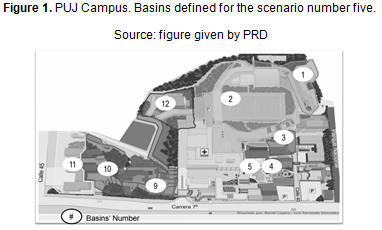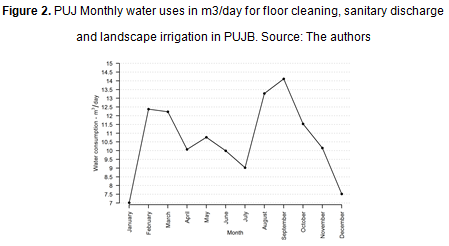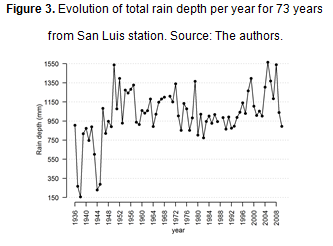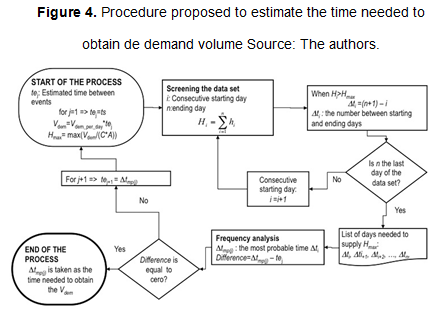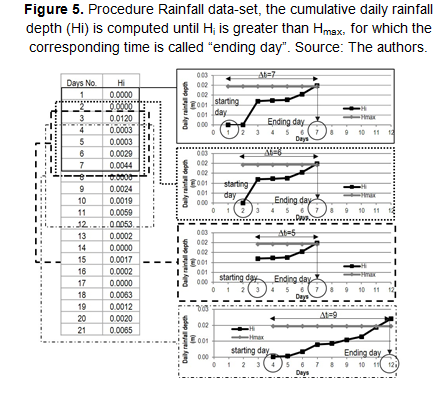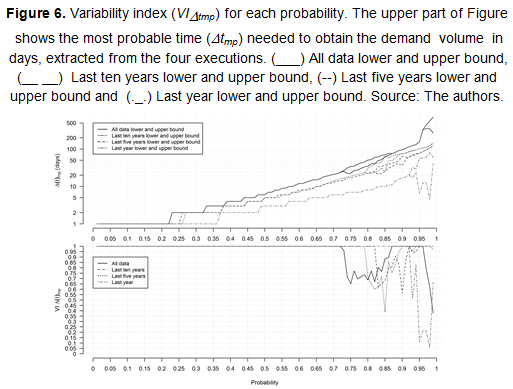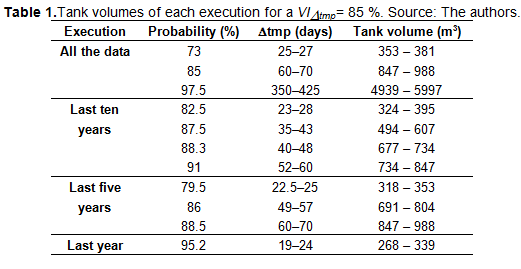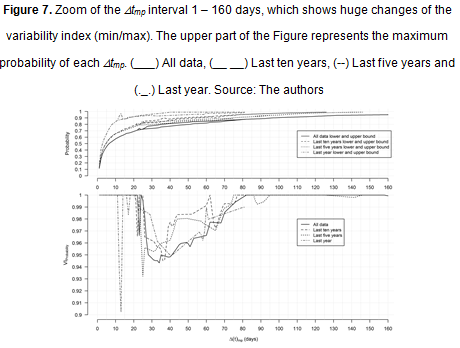|
SIZING METHOD FOR STORMWATER HARVESTING TANKS USING DAILY RESOLUTION RAINFALL AND WATER DEMAND DATA SETS
Sandra Galarza-Molinaa Andrés Torresb
Recibido el 8 de febrero de 2016, aprobado el 15 de septiembre de 2016 y actualizado el 19 de junio de 2017
DOI: 10.17151/luaz.2017.45.7
Abstract
This work presents a simplified method for rainwater harvesting (RWH) tank sizing using long day-resolution rainfall time series. This method considers heterogeneous contributing catchments and water demand flow rates. For the tank sizing, we proposed to take into account the probability to supply the water demand, as well as the most needed probable time step and their respective variabilities. The method was applied to a specific case study (Pontificia Universidad Javeriana, RHW project), with 73 years of daily-resolution rainfall information (between 1936-2010). For the analysis we used different time periods from data-set and the results were: (i) for the whole data-set 76 years: 395 m3 (28 days, probability: 78%); (ii) for the last ten years: 494 m3 (35 days, probability: 89%); (iii) for the last five years: 346 m3 (25 days, probability: 84%); (iv) for the last year: 155-198 m3 (11-14 days, probability: 89-90%). These results seem to be influenced by an evolution of rainfall depth in different selected periods, which will be studied in further researches. Key words: rainwater harvesting system (RWH); time series; rainwater tank sizing; urban water management; water demand.
MÉTODO DE DIMENSIONAMIENTO PARA TANQUES DE CAPTACIÓN DE AGUA LLUVIA UTILIZANDO SERIES DE RESOLUCIÓN DIARIA DE LLUVIA Y DE DEMANDA DE AGUA
Resumen
Este trabajo presenta un método simplificado para el dimensionamiento de tanques de aprovechamiento de aguas lluvias (AAL). Este método considera cuencas tributarias heterogéneas y caudales de demanda de agua. Se propone tener en cuenta la probabilidad para suministrar la demanda de agua, así como el paso de tiempo necesario de recolección más probable y sus respectivas variabilidades. El método se aplicó a un estudio específico de caso (Pontificia Universidad Javeriana, proyecto AAL), con 73 años de información de precipitación a resolución diaria (entre 1936-2010). Para el análisis se utilizaron diferentes períodos de tiempo, los volúmenes del tanque con el tiempo de recolección fueron los siguientes: (i) para el conjunto entero de datos 76 años: 395 m3 (28 días, probabilidad: 78%); (ii) para los últimos diez años: 494 m3 (35 días, probabilidad: 89%); (iii) para los últimos cinco años: 346 m3 (25 días, probabilidad: 84%); (iv) para el último año: 155 a 198 m3 (11 a 14 días, probabilidad: 89-90%). Estos resultados parecen estar influenciados por una evolución de la altura de lluvia en los diferentes períodos seleccionados, lo cual será estudiado en investigaciones posteriores.
Palabras clave: sistemas de aprovechamiento de aguas lluvias; series de tiempo; dimensionamiento de tanques para aprovechamiento de aguas lluvias; gestión de agua urbana; demanda de agua.
INTRODUCTION
Nowadays it exists an increasing attention on the rainwater harvesting (RWH) as an alternative source of water (Hatt, Deletic, & Fletcher, 2006) for non-potable uses (Appan, 2000; Coombes, Argue, & Kuczera, 2000; Coombes & Mitchell, 2006; EPA, 2004; Fewkes, 1999; Ghisi, Tavares, & Rocha, 2009; Handia, Tembo, & Mwiindwa, 2003; Hatt et al., 2006; Herrmann & Schmida, 2000; X.-Y. Li & Gong, 2002; Marinoski, Ghisi, & Gómez, 2004; Wong, 2007) which is additionally recognized as one of the specific adaptation strategies that the water sector should implement to deal with climate changes (Aladenola & Adeboye, 2009; Boelee et al., 2012; Mukheibir, 2007; Muller, 2007; Mwenge Kahinda, Taigbenu, & Boroto, 2010; Pandey, Gupta, & Anderson, 2003; Rozos, Makropoulos, & Butler, 2010). This technique have been successfully implemented as alternative water source in some countries such as China (F. Li, Cook, Geballe, & Burch Jr, 2000), South Korea (Song, Han, & Kim, n.d.), Malaysia (Lariyah, Mohd Nor, Mohamed Roseli, Zulkefli, & Amirah Hanim, 2011), Australia (Duan, Attwater, & Min, 2008) and Brazil (Ghisi et al., 2009). Typically, today's questions which have to be answered through research and engineering studies about the use of RWH are (Mitchell, McCarthy, Deletic, & Fletcher, 2008): “How much stormwater can be harvested? How reliable is this supply source? (Farreny, Gabarrell, & Rieradevall, 2011) And how large a storage is required?”
One of the most widely studied options for saving the rainwater harvested is the use of rainwater tanks. Typically, the studies about rainwater tanks focus on the design optimization (Campisano & Modica, 2012; Imteaz, Rahman, & Ahsan, 2012; Imteaz, Shanableh, Rahman, & Ahsan, 2011; Seo, Choi, & Park, 2012) and the performance of rainwater tanks considering the annual rainfall at a specific geographic location, homogeneous catchment area (only one type of surface – e.g. roofs – are considered) and water demand patterns (Fewkes, 1999; Jenkins, 2007; Khastagir & Jayasuriya, 2010; Walsh, Pomeroy, & Burian, 2014). Other studies focus on the effect that produces the use of rainwater tanks on the sewer system design (Vaes & Berlamont, 2001). More recently, (Youn, Chung, Kang, & Sung, 2012) developed a methodology that establishes a probabilistic relationship between the storage capacity and the deficit rate of a rainwater harvesting system considering climate change.
In Colombia some researches about RWH have been developed for potable (Sanchez & Caicedo, 2003) and non-potable uses (Ballén, Galarza, & Ortiz, 2006; Lara Borrero et al., 2007; Palacio Castañeda, 2010; Ramírez, 2009; Torres, Méndez-Fajardo, et al., 2011). (Ballén et al., 2006) concluded that the feasibility of RWH depends on five variables: Precipitation of the area, house cover’s area, water availability to supply, price per cubic meter of water and investment needed for the systems’ construction and maintenance. On the other hand, in Colombia some sizing methodologies based on maximum intensities, and hence more adapted to flooding control, have been developed and implemented (Galarza & Garzón, 2005; Mora, Alvarado, & Torres, 2011; Navarro & Saldarriaga, 2008; Torres et al., 2012; Vélez et al., 2004). This paper presents a tank sizing simplified methodology specifically for RWH purposes and adapted to developing countries (low and medium hydrological data resolution) for non-potable uses of rainwater runoff from heterogeneous catchments.
MATERIALS
The study case is the Pontificia Universidad Javeriana Bogotá (PUJB) RWH project. The PUJB campus includes 18.4 ha and almost 200000 m2 of constructions where academic, administrative, parking areas, chapels, banks, meeting and other service buildings, as well as sport fields and green zones can be found. Every day, approximately 30000 people enter the campus, whose some buildings are up to 70 years old, but mostly around 40 years and several are recent constructions. It is located at the north-east of Bogota’s center (Torres, Estupiñán Perdomo, & Zapata García, 2011).
The RWH project in the PUJB was born within the framework of the PUJB Environmental Management Plan. A first project was proposed with the objective of assess economic and technical feasibilities of RWH as an alternative for irrigation and washing hard areas and buildings’ facades. This project was leaded by the Research Group Ciencia e Ingeniería del Agua y el Ambiente (from the same university) in order to determine the amount of water potentially usable. Results show the possibility of using rainwater for some uses, from the standpoint of the amount of water (Lara Borrero et al., 2007). As a result, measurement campaigns were conducted to know the quality of the stormwater on campus and to identify potential uses (Torres, Lara-Borrero, Torres, Estupiñan, & Méndez-Fajardo, 2011). Taking into account these results, Torres et al. (2011) undertook a study to identify the infrastructure requirements for the sustainable use of rainwater on the university campus. They concluded that rainwater could supply a maximum demand of 14%, requiring large investments and a change in the cultural model of water use.
Subsequently, a MCA (Multi Criteria Analysis) tool (called CRIDE: multiCRIteriaDEcision support tool – it’s a Celtic word that means heart (Davis, 2002)) for supporting the process of decision making for RWH in PUJB campus was developed (Galarza-Molina, Torres, Moura, & Lara-Borrero, 2015). Six scenarios were proposed for RWH and, by applying CRIDE, the University’s Physical Resources Division (PRD) chose the scenario number five. This scenario consists of the runoff collection on nine basins (Figure 1) (basins number 1, 2, 3, 4, 5, 9, 10, 11 and 12) for non-potables uses quality (floor cleaning, sanitary discharge and landscape irrigation) (as recommended by (Torres et al., 2011) using SUDS (Sustainable Urban Drainage Systems) as basins, bioretention gardens, permeable paving and constructed wetlands (CIRIA, 2000) for collection and treatment of the rainwater (Galarza-Molina et al., 2015).
The design and construction of the scenario number five will begin with the RWH of one of the nine basins (basin number 2), using a constructed-wetland / reservoir-tank system. Basin number 2 represents 15% (2.73 ha) of the total campus area, with a contributing catchment of 2.2 ha and with a weighted runoff coefficient of 0.51.
The inventory of water uses was taken from Torres et al. (Torres et al., 2011). Scenario number five considers the use of non-potable water uses. These monthly water uses range between 7.02 m3/day and 14.11 m3/day (Figure 2).
METHODOLOGY
A script based on Rational Method was developed in R (R Development Core Team, 2012) considering daily rainfall, contributing catchment and water uses. We chose this method because of the size of the catchment (less than 80 ha) and its simplicity. The input data were the 73 years of inter-monthly precipitation information between 1936 and 2010 (without years 1969 and 1988 with no data) (Figure 3) and the water uses (demand). The rainfall data-set was collected from a daily rain gauge near the university campus (San Luis - type: Pluviograph station; latitude: 4°38’; longitude: 74°02’; elevation: 3000 m). The water demand was calculated from water bills (October 2003 - March 2010) delivered by PRD. The contributing catchment has a surface of 22026m2, composed by a sport centre, a parking structure, a sport field and green zones and roads, with a weighted runoff coefficient of 0.51.
Figure 4 shows the process proposed for estimating the time needed to obtain de demand volume. This process is divided in five steps. The first one is the determination of the maximum value of storage Hmax needed to supply the water demand. Hmaxis calculated using the amount of water needed per month, the contributing catchment characteristics (area and runoff coefficient) and the estimated time between events (tej). In order to begin the iterative procedure explained below, we used a time seed (ts) (the script is executed for ts from 1 day to 100 days) for the first tej. The second step is the screening the data-set from the first (i=1) to the last day (i=n) for consecutive starting days i. Then the cumulative daily depth height (Hi) is computed until Hi is greater than Hmax. The third step is undertaken when Hi>Hmax, the number days between starting and ending days (time in days needed to supply Hmax) is recorded as ∆ti, and the procedure is undertaken again with the next consecutive starting day (i+1) (see Figure 5). The result of this step is a list of days needed to supply Hmax: ∆ti, ∆ti+1, ∆ti+2, …,∆tn, where i denotes the starting day. By using a frequency analysis (fourth step), the most probable time ∆ti to obtain the demand volume is calculated (∆tmp(j)), and is compared with tej. If they are equal (fifth step), ∆tmp(j) is taken as the time needed to obtain the demand volume; otherwise the process will begin again with ∆tmp(j) as tej+1 until there is no difference between tej+k and ∆tmp(j+k).
The script was executed four times using different parts of the data-set: with all the data, with the last ten years, with the last five years and the last year. For the analysis of these results it was constructed a confidence interval graph with equations 1 and 2, using the first (Q1) and the third quartiles (Q3) to define the confidence intervals bound.
Upper_bound=Q_3+1.5*(Q_3-Q_1) (1) Lower_bound=Q_1-1.5*(Q_3-Q_1) (2)
To support the selection of ∆tmp (the most probable time to obtain the demand volume) two variability indexes (VIi) are calculated using equation 3 and 4: the relation between the minimum ∆tmpi and maximum ∆tmpi; and the relation between the minimum (min P(∆tmpi)) and maximum (max P(∆tmpi)) probability which each ∆tmp would have.
〖VI〗_i∆tmp=min(∆t_mpi )/max(∆t_mpi ) (3) 〖VI〗_iProbability=minP(∆t_mpi )/maxP(∆t_mpi ) (4)
∆tmp is chosen taking into account three criteria: higher values of VIi∆tmp and VIiProbability (difference between upper and lower bounds), lower values of ∆tmp to avoid oversized tank and high retention times (number of days are proportional to the amount of stored water) and higher values of probability of ∆tmp.
RESULTS AND DISCUSSION
With the script described above, the rainfall data-set, the water uses (demand) and time seed (ts) from 1 to 100 days, the results were extracted from four executions:
With all the rainfall data-set With the last ten years of the rainfall data-set With the last five years of the rainfall data-set With the last year of the rainfall data-set
Taking into account the methodology for the selection of the ∆tmp, the variability indexes (VIi∆tmp and VIiProbability) were calculated. Figure 5 shows VIi∆tmp for each probability and the most probable times (∆tmp) needed to obtain the demand volume in days.
For the first execution, (upper part of Figure 6), with all the rainfall data-set (solid line type), ∆tmp varies between 1 day and 641 days. Significant differences between the probabilities’ intervals of 73% – 86% and 97% – 99% can be observed, for the ∆tmp confidence bounds. For the last ten years of the rainfall data-set (dashed line type) ∆tmp varies between 1 day and 125 days. Significant differences between the probability’s interval of 83% and 94% can be observed for the confidence bounds of ∆tmp. In the case of the execution of the last five years of the rainfall data-set (dotted line type), ∆tmp varies between 1 day and 144 days. Highest differences between the confidence bounds of ∆tmp were found in the probability’s interval of 80% and 89%. Finally, for the execution with the last year of the rainfall data-set (dot-lined type), ∆tmp varies between 1 day and 53 days. In this case significant differences for median values and confidence bounds of ∆tmp were found in the probability’s interval of 93% and 99%.
On the other hand, taking into account the first criterion (high values of VI) it was chosen a high value of VI∆tmp = 85% (lower part of Figure 6). The results for each execution are shown in Table 1: the tank volume is calculated with the maximum demand value (14.11 m3/day, Figure 2) and the corresponding ∆tmp value.
The Figure 7 shows the ∆tmp versus VIProbability. First it was chosen a high value of VIProbability = 95%. The results for each execution are shown in Table 2, the tank volume is calculated with the maximum demand value (14.11 m3/day, Figure 2) and ∆tmp values.
In accordance with the second criteria (lower values of ∆tmp to avoid oversized tank and high retention times) it was chosen ∆tmp between 20 and 30 days (282 and 423 m3). For this time step the minimum VI∆tmp is 0.735 (from the all data execution, see Figure 6) and VIProbability is 0.93 (from last five years execution, see Figure 7). The corresponding probabilities range between 69% and 93% for VI∆tmp (Figure 6) and between 69% and 98% for VIProbability (considering all the executions, see Figure 7). If we chose another time step ∆tmp lower than 30 days, for example between 15 and 20 days (212 and 282 m3), the minimum VI∆tmp is 1 (from the all data execution, see figure 6) and VIProbability is 0.985 (from the last five years execution, see Figure 7) with a probability between 64% and 94.5% for VI∆tmp (Figure 6) and between 65% and 90% for VIProbability (considering all the executions, see Figure 7).
On the other hand, in accordance with the third criteria (higher values of probability of ∆tmp) if we chose probability values upper than 60%, it can be obtained ∆tmp values higher than 12 days (169 m3) (see figure 5 and 6). It seems important to study in detail the ∆tmp intervals 14 to 16 (198 and 226 m3) days and 18 to 20 days (254 and 282 m3) (Figure 7): in these intervals VIProbability values for all the executions are the highest, with a minimum value of 0.985. The time step probability for the intervals 14 to 16 days and 18 to 20 days are between 63% and 89% and between 67% and 92%, respectively. Hence, it can be chosen any ∆tmp within these intervals – 14-16 or 18-20 days – (e.g. for ∆tmp = 20 days with VI = 1 and a probability between 70% and 90%, with a tank capacity of 282 m3).
CONCLUSIONS
This paper proposes a simplified method to sizing rainwater tanks using long day-resolution rainfall time series for heterogeneous catchment areas. This is a specific method based on the probability that has the daily rainfall to supply the water demand, as well as the most probable time step needed and their respective variabilities.
After applying this method to a specific case study (PUJ campus rainwater harvesting tank sizing) we found that the results differ depending on the selected period and the variability indexes: (i) whole data series - 76 years: 395 to 593 m3 (VIProbability= 95%: 28 to 42 days, probability range: 73-82 ) and 353 to 5997 m3 (VI∆tmp= 85%: 25 to 425 days, probability range: 73-97.5%); (ii) last ten years: 508 and 529 m3 (VIProbability= 95%: 36 and 37.5 days, probability range: 84-89%) and 324 to 847 m3 (VI∆tmp= 85%: 23 to 60 days, probability range: 82.5% – 91%); (iii) last five years: 346 and 360 m3 (VIProbability= 95%: 25 and 26 days, probability range: 79-84%) and 318 to 988 (VI∆tmp= 85%: 22.5 to 70 days, probability range: 79.5-88.5%); (iv) last year: 169 to 593 m3 (VIProbability= 95%: 12 to 42 days, probability range: 86-99%) and 268 and 339 (VI∆tmp= 85%: 19 and 24 days, probability: 95.2%). The above results seem to be influenced by an evolution of rainfall depth in different selected periods, which will be studied in further researches by considering a possible climate change.
REFERENCES
a. MSc. Hidrosistemas. Profesor titular, Facultad de Ingeniería Civil, Pontificia Universidad Javeriana, Bogotá, Colombia. This email address is being protected from spambots. You need JavaScript enabled to view it.
b. PhD. Profesor Asociado, Facultad de Ingeniería Civil, Pontificia Universidad Javeriana, Bogotá, Colombia. This email address is being protected from spambots. You need JavaScript enabled to view it.
Galarza-Molina S., received the Bs. Eng in Civil Engineering in 2005, the MS degree in Hydrosytems in 2011. Now she is a PhD student at Pontificia Universidad Javeriana. Her research interests includes: SUDS – Sustainable Urban Drainage Systems, Stormwater Harvesting, Decision making in Urban Drainage.
Torres A., received the Bs. Eng in Civil Engineering in 1999, MS degree in Civil Engineering in 2001 and PhD in Civil Engineering in 2008. Now he is an Associate Professor at Pontificia Universidad Javeriana. His research interests include: Urban hydrology, SUDS – Sustainable Urban Drainage Systems, Urban Drainage Management.
Para citar este artículo: Galarza-Molina, S., y Torres, A. (2017). Sizing method for stormwater harvesting tanks using daily resolution rainfall and water demand data sets. Revista Luna Azul, 45, 107-122. DOI: 10.17151/luaz.2017.45.7 |













